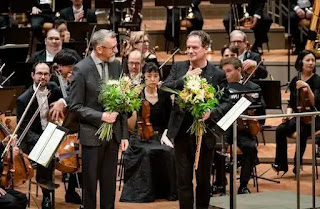Paavo Järvi conducts a feast for the musical intellect in Berlin
BachTrack
Zenaida des Aubris
29.05.2022
Photo credits: Stephan Rabold
A world premiere makes any concert a special occasion and this commission by the Berliner Philharmoniker to the Estonian composer Erkki-Sven Tüür proved the point. His Concerto for Flute and Orchestra dedicated to, and performed by, their principal flautist Emmanuel Pahud, proved to be the highlight of this evening. The sophisticated, upbeat programme was akin to a three-course gourmet meal with Sibelius' Symphony no. 7 in C major to start, Tüür as a hearty main dish, and Beethoven's Eighth Symphony as a scrumptious dessert.
Jean Sibelius' reputation as a painter of sound is fully applicable to his last completed symphony, his Seventh, from 1924. Just one, 22-minute long movement suffices to evoke the vast Finnish taiga, to hint at the flight of swans or the dancing aurora borealis of the far north. Paavo Järvi, himself a child of the north, understands this music and, with the excellent brass and woodwinds of the Berliners, painted these sound pictures with broad strokes and elicited feelings of yearning for this natural beauty.
By now it is no longer just insider knowledge that the small country of Estonia (approximate population 1.4 million) is over-proportionally rich in musical talent. Tüür is one of Estonia's most prominent and prolific composers today. Born on the small island of Hiiumaa in 1959 and completing his studies in Tallinn, he headed a rock group before turning to composition. He has written nine symphonies and a rich body of work for diverse instruments.
Titled Lux Stellarum, his demanding Flute Concerto clearly reflects the composer's predilections for what he believes to be cosmic sound images. The solo flute translates the swooshes of falling stars, the explosions of faraway galaxies into sometimes dissonant cadences, sometimes blown whispers, sometimes melodious lines. The flute is supported by a full orchestra and an especially sophisticated percussion section. The fact that Tüür initially trained as a flautist and a percussionist no doubt has influenced his composition and choice of instruments for this section: all manner of drums, gongs, glockenspiel, vibraphone, cymbals, xylophones, bells and rain-sticks kept all four percussionists of the Berliners busy in order to acoustically depict the Lux Stellarum, the light games of the universe.
In the first of four movements, titled Fading Stardust, the flute ripples harmoniously, dissolving into soft xylophone, bells and chimes that depict a process of dissolution with falling tone rows. In contrast, Dancing Asteroids, the fittingly named second movement, is full of trills and scales bubbling in intergalactic nebulae. In the third movement, Litany of the Dying Stars, the flute leads us into a mysterious and mournful, far-reaching, ethereal sound space where everything floats, free and lost, seemingly limitless. In the finale – entitled Flooding Galaxies – the focus is turned to the macrocosmos with the various groups of instruments moving toward a climax full of rhythmic energy. Unquestioningly, Pahud’s virtuosity stems from his musical versatility and intrinsic understanding of this work dedicated to him.
Following on the Tüür piece with only a short reseating interval, Järvi's take on Beethoven's Eighth had to be anything but elegiac; indeed, Järvi brought a Beethoven sounding young, brash and rebellious. There was nothing coy about this interpretation; it bubbled over with cheerfulness and youthful liveliness. Under Järvi's direction, the excellent Berliners relished his dynamic reading of the score.
Surely the warm reception of the audience was also an expression of joy at being able to attend a live concert again without the constrictions of masks or proof of vaccinations against Covid.

Comments